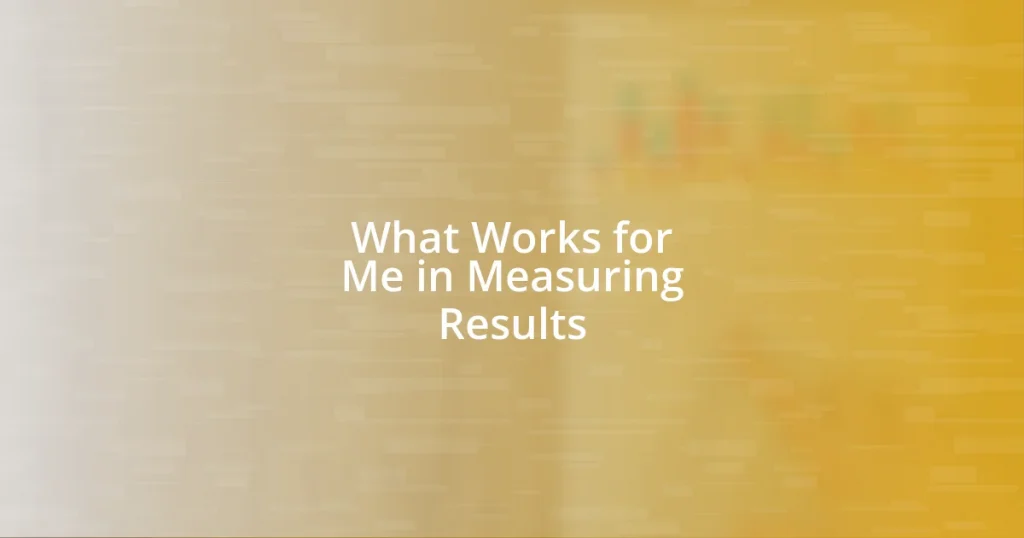Key takeaways:
- Customize KPIs to align with specific goals, shifting focus from generic metrics to meaningful outcomes for better clarity and motivation.
- Set measurable and specific goals rather than vague intentions to track progress and build confidence through small, achievable targets.
- Utilize effective tools and techniques for data collection and analysis, emphasizing the importance of flexibility and aligning strategies with audience needs.

Defining Key Performance Indicators
Defining Key Performance Indicators (KPIs) isn’t just about numbers; it’s about understanding what drives success in your specific context. I vividly remember grappling with whether to measure website traffic or lead conversions when I first started my project. It dawned on me: focusing on lead conversions aligned more with my ultimate goal of building a client base, which felt like a light bulb moment for me.
When I think about KPIs, I often ask myself, “What outcome truly reflects my efforts?” For instance, I used to track social media engagement without considering its direct impact on my business growth. Once I shifted to measuring how engagement translated into actual sales, I saw a shift in my strategy that energized my work and provided clarity on what to prioritize.
It’s essential to customize your KPIs to fit your unique goals. I learned this the hard way by initially applying generic metrics to my efforts, only to feel lost in the data. Now, I advocate for choosing KPIs that resonate with your personal experiences and objectives, because when they do, tracking progress becomes not only meaningful but also exciting.

Establishing Measurable Goals
Establishing measurable goals begins with precision. I can still recall a time when I decided to target a vague intention of “improving client engagement.” It was only when I refined that into specific goals—like increasing my email open rates by 20% in three months—that I truly saw progress. Seeing tangible growth fueled my motivation and shifted my approach to client interactions.
Breaking down my broader ambitions into smaller, manageable targets has been pivotal. For example, while I always sought to expand my audience, I now focus on targeting a specific number of new followers every week. By measuring this, I gained clarity and purpose, transforming what once felt overwhelming into a series of achievable steps. I believe each small win builds confidence and momentum, reinforcing the importance of focusing on measurable achievements.
To visualize this impact, I recommend comparing different approaches to goal-setting. Here’s how a more defined goal can enhance your strategies:
| Goal Type | Description |
|---|---|
| Vague Goals | General intentions like ‘increase sales’ without specifics. |
| Measurable Goals | Specific targets like ‘boost website sales by 15% over the next quarter.’ |

Choosing the Right Tools
Choosing the right tools can be a game-changer in how effectively I measure results. In my journey, I experimented with various resources before finding what truly resonated with my needs. The moment I streamlined my toolkit was enlightening; it revealed that using certain software not only simplified the data collection process but also provided deeper insights, making everything feel less daunting and more manageable.
Here’s a handy list of tools I often rely on to quantify my successes:
- Google Analytics: Offers comprehensive data about website traffic and user behavior, which I find essential for understanding audience engagement.
- Trello: A fantastic project management tool that helps me keep track of my goals and progress in one organized, visual space.
- Hootsuite: This social media management platform allows me to plan and analyze my social media performance, helping me connect engagement to conversions.
- Microsoft Excel or Google Sheets: Two tools that never go out of style for tracking and analyzing data to see my performance metrics over time.
Each tool serves a unique purpose, and finding the right balance among them has truly empowered my efforts. I’ve learned that it’s not always about having the latest software but rather finding what suits my style and enhances my focus on results.

Collecting and Analyzing Data
When it comes to collecting and analyzing data, I’ve found that clarity in what you’re measuring makes all the difference. For instance, I used to gather every bit of data available, thinking more was better. However, I quickly learned that focusing on key performance indicators (KPIs) relevant to my goals not only made data collection less overwhelming but also provided more actionable insights. Have you ever tried sifting through a mountain of data and felt lost? I certainly have, and narrowing down what truly mattered transformed my data journey.
A practical approach that has worked for me involves setting up regular intervals for data analysis. For example, I now dedicate the last Friday of each month to reviewing my metrics. During this time, I reflect on what the numbers mean, connecting them to my established goals. This routine has not only helped keep my focus sharp but has also instilled a sense of anticipation; it feels like unwrapping a present to see what progress has been made. How often do you pause to reflect on your progress? It’s those moments that lead to powerful insights.
I’ve also adopted visualization techniques to better understand data trends. Using simple graphs and charts has made it easier for me to spot patterns that might otherwise go unnoticed. When I plotted my engagement rates week by week, I could see the effect of a new strategy I implemented. This visual representation brought excitement as I could directly correlate my efforts with real results. Have you ever seen your hard work come to life in a graph? That’s when the numbers truly start to resonate.

Evaluating Measurement Techniques
Evaluating measurement techniques is essential if you want to understand their value fully. In my experience, the technique I choose to evaluate must align with the specific goals I’m pursuing. For example, a few months ago, I decided to implement A/B testing for my email campaigns. This hands-on approach allowed me to compare two versions of my emails, and the results not only clarified which design drove better engagement, but it also sparked a deeper curiosity within me about my audience’s preferences. Have you ever felt that thrill when discovering just what resonates with your audience?
One technique I often revisit is qualitative feedback. I remember a time when I sent out a survey asking my subscribers about their experience. The responses were eye-opening; they highlighted areas of improvement I hadn’t even considered. Often, numbers alone don’t tell the full story. Engaging directly with your audience can bring forth insights that metrics might overlook. It became clear to me that combining qualitative and quantitative measures provides a richer understanding of success. Have you ever wished you could peer behind the curtain of cold, hard data? That’s where the gold lies.
Additionally, I’ve developed a habit of revisiting past measurement techniques every few months to assess their effectiveness. There’s something gratifying about reflecting on what worked and what didn’t. For instance, one seasonal campaign didn’t yield the anticipated results, prompting me to analyze my timing and messaging. Hindsight is truly a powerful tool, isn’t it? This iterative process not only enhances my strategy but also fosters a growth mindset—one that embraces learning through evaluation. Letting go of a technique that no longer serves me has been a liberating experience, allowing me to remain flexible and innovative.

Adjusting Strategies Based on Results
When I examine the results of my efforts, adjusting my strategies feels like turning the steering wheel to stay on course. I remember launching a social media campaign that initially showed promise, but engagement quickly fizzled. Instead of sticking to my original plan, I decided to tweak my approach midway, testing new content formats that resonated more with my audience. Have you ever had to pivot your strategy mid-course? That moment of uncertainty turned into an opportunity for growth, and it ultimately revitalized my campaign.
Another experience really drove home the importance of flexibility. I had implemented a new content-sharing schedule based on what had previously worked, only to find that my audience’s habits had shifted. Rather than feeling defeated, I embraced the change by experimenting with different posting times and formats. The moment I saw my engagement rates climbing again, it felt like an exhilarating breakthrough! This taught me that being responsive to the data, rather than rigidly adhering to a single strategy, often yields more fulfilling results.
I’ve also discovered that sometimes it’s not just about the metrics; it’s about the narrative behind them. Once, after receiving feedback from my community, I recognized a shift in their needs that didn’t align with my existing content. I felt a sense of urgency to adapt, creating new resources that addressed their concerns. That process was not only rewarding but also deepened my connection to my audience. Have you ever felt that transformational shift when your content truly aligns with your audience’s needs? It’s those moments that remind me why adjusting strategies based on results is not just beneficial but essential.

Reporting and Visualizing Outcomes
When it comes to reporting and visualizing outcomes, I find that clear visuals can transform dry data into engaging stories. I once created a dashboard to track my website’s performance metrics, and the impact was immediate. By utilizing graphs and charts, I could easily identify trends—like peak visitor times and popular content—at a glance. Have you ever noticed how a well-placed chart can spark an ‘aha’ moment? It’s as if the data suddenly comes to life, guiding my decisions in real-time.
Furthermore, I’ve made it a point to tailor my reports for different audiences. I remember preparing a presentation for a mixed group of stakeholders, some of whom were data-savvy while others weren’t. Crafting a narrative thread through the numbers—not just presenting them—allowed me to connect with everyone. By using storytelling elements along with visual aids, I felt the audience become genuinely engaged. How do you communicate your findings to ensure everyone is on the same page? I’ve learned that the right combination of visuals and narratives can make all the difference.
Lastly, reflecting on feedback after presenting my reports has been key to refining my approach. After one particular presentation, I was surprised to hear questions that unwrapped layers I hadn’t anticipated. That experience taught me that reporting is not just about showcasing results; it’s a dialogue. Engaging with my audience regarding their thoughts on the visuals provided insights that I could incorporate into future reports. Isn’t it fascinating how conversations around data can open doors to even deeper understanding? It’s these interactions that have enhanced my reporting process and made it more effective overall.















